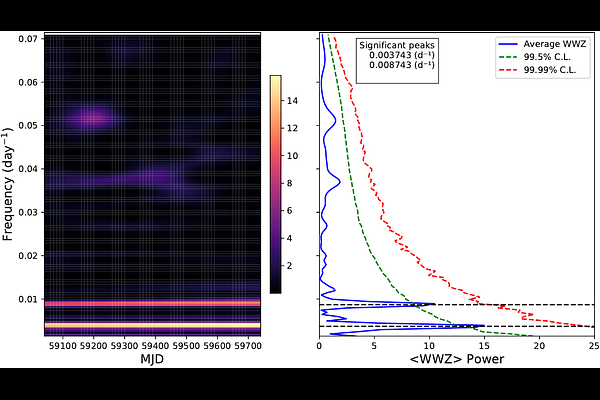Evidence for Dual Periodic Signatures in PKS 0805-07 from Multi-technique Time Series Analysis

Evidence for Dual Periodic Signatures in PKS 0805-07 from Multi-technique Time Series Analysis
Sikandar Akbar, Zahir Shah, Ranjeev Misra, Sajad Boked, Naseer Iqbal
AbstractWe report the identification of two statistically significant quasi-periodic oscillations in the weekly binned $\gamma$-ray light curve of the flat-spectrum radio quasar PKS 0805$-$07, observed by Fermi-LAT over the period MJD 59047.5-59740.5. By applying a suite of complementary time-series analysis techniques, we identify periodic signatures at approximately 255 and 112 days. These techniques include the Lomb-Scargle periodogram (LSP), Weighted Wavelet Z-transform (WWZ), REDFIT, Date-Compensated Discrete Fourier Transform (DCDFT), Phase Dispersion Minimization (PDM), and the String-length method. The reliability of these signals is supported by high local significance (> 99) in all methods and reinforced through phase-folding. Model selection using the Akaike Information Criterion (AIC) and Bayesian Information Criterion (BIC) strongly supports a two-component periodic model. The detection of dual QPOs is rare among blazars and suggests complex variability mechanisms. Although a binary supermassive black hole (SMBH) scenario could be considered given the sources high redshift (z = 1.837), the short periodicities are difficult to reconcile with orbital motion unless invoking extreme parameters. Double-sine model fitting reveals that the oscillatory components have comparable amplitudes but are out of phase, suggesting a potential beating phenomenon due to interference. This amplitude-modulated variability is consistent with a geometric origin, most plausibly jet precession driven by Lense-Thirring torques, superimposed with a secondary process such as polar jet oscillation. Doppler factor modulation arising from these effects can account for the observed flux variations without requiring an unrealistically compact binary.